
Multiple Choice Questions in Surveys: Types, Examples, and Best Practices
Designing a survey is all about picking the right tools to get answers you can trust, and that’s where question types for surveys come in.
Among the many types of survey questions out there, multiple choice questions (MCQs) stand tall as a go-to for a reason. They’re quick, clear, and give respondents a straightforward way to share what they think.
Whether you’re digging into opinions or stats, MCQs are a staple in the survey game, making them super useful for everything from customer feedback to research polls.
Polling.com makes it even easier. It lets you create surveys with multiple choice questions fast, so you’re not fumbling around trying to figure out how to reach respondents effectively.
What Are Multiple Choice Questions?
So, what’s a multiple choice question in the context of surveys?
It’s a question type where you give respondents a stem, like “How satisfied are you with our service?”, followed by a set of options (Very Satisfied, Satisfied, Neutral, Dissatisfied), and they pick either one answer or, in some cases, multiple selections if you allow it.
It’s a clear prompt plus a list of choices that keeps things structured, and it’s way different from open-ended questions.
Multiple choice questions are the most commonly used of the types of questions in surveys because they’re easy for respondents to tackle and simple to analyze.
Question types multiple choice cut through the noise, delivering clean data fast.
That’s why they’re everywhere, from quick polls to deep dives, making them a top pick for anyone looking to nail down solid answers without the fuss.
Types of Multiple Choice Questions
Multiple choice questions come in a few flavors, and knowing the different types of questions in surveys can help you pick the right one for your goal.
Here’s the rundown with examples to show how they work for respondents.
Single-Answer Multiple Choice Questions
Single-answer multiple choice questions are the classic type. They let respondents pick just one option from the list, and that’s it.

Think “What’s your favorite color?” with choices like Red, Blue, Green, or Yellow. Only one can be the winner, so it keeps your questions clean and simple.
Single answer format questions are best used when you need clear, mutually exclusive options, where overlap is not a thing.
This question types multiple choice setup cuts confusion and gives you crisp data fast. It’s perfect for nailing down a single preference or fact.
Multiple-Answer Multiple Choice Questions
On the flip side, multiple-answer multiple choice questions let respondents select more than one option, like “Which social media platforms do you use? (Facebook, X, Instagram, TikTok)”.
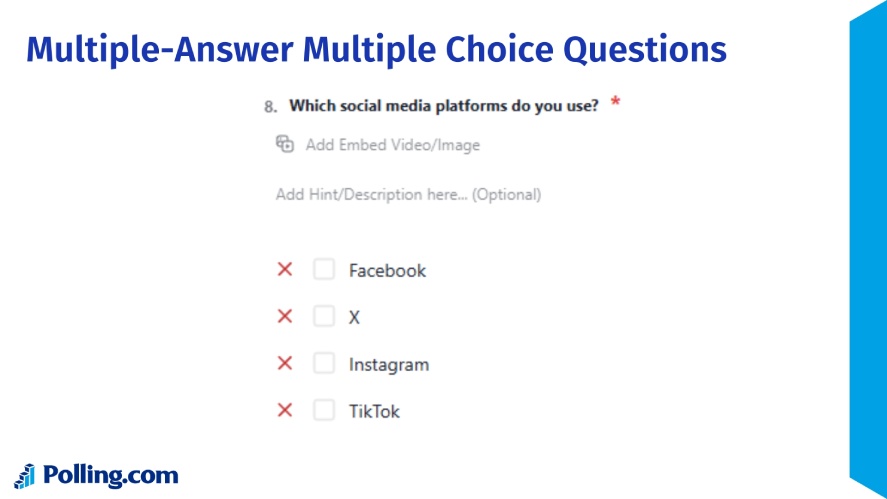
It’s a solid pick when you want to gauge broader preferences or multi-dimensional opinions, where respondents might love a few at once.
These types of survey questions dig into the bigger picture, giving you richer survey responses without forcing a single pick.
Rating Scale Multiple Choice (Likert-style)
Rating scale multiple choice questions, like Likert-style, sometimes get mixed up with standalone ratings.
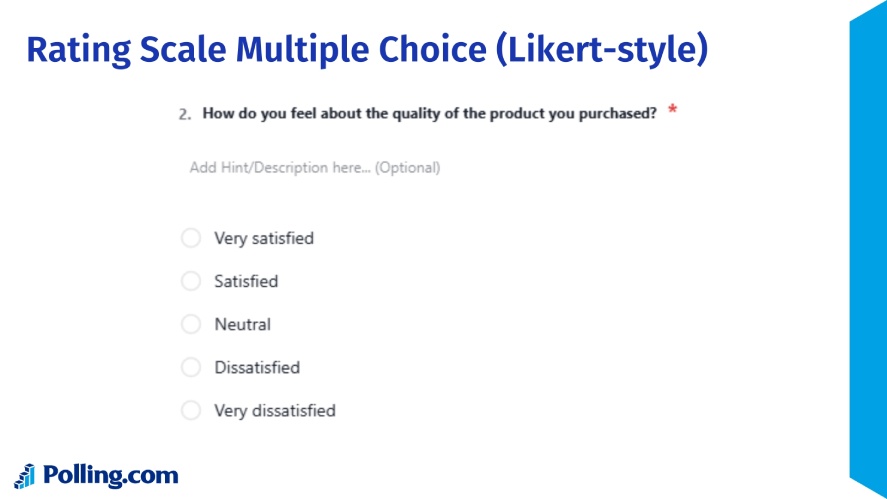
However, they’re a legit form of MCQ where respondents choose from a range, like “How satisfied are you with our service? (Very Satisfied, Satisfied, Neutral, Unsatisfied, Very Unsatisfied)”.
They’re super common in satisfaction or opinion-based surveys because they turn feelings into tidy data. Among question types for surveys, this one is a star for measuring shades of thought, blending structure with nuance.
Dropdown Multiple Choice
Dropdown multiple choice questions are a space-saving twist.
They’re perfect for long lists where showing all options at once would clog the screen, like “What’s your job title?” with dozens of roles as survey answer choices.
This type keeps things sleek, especially in online polls, and works smoothly for respondents picking from a big set without scrolling forever.
Image-based Multiple Choice Questions
Image-based multiple choice questions bring visuals into the mix.
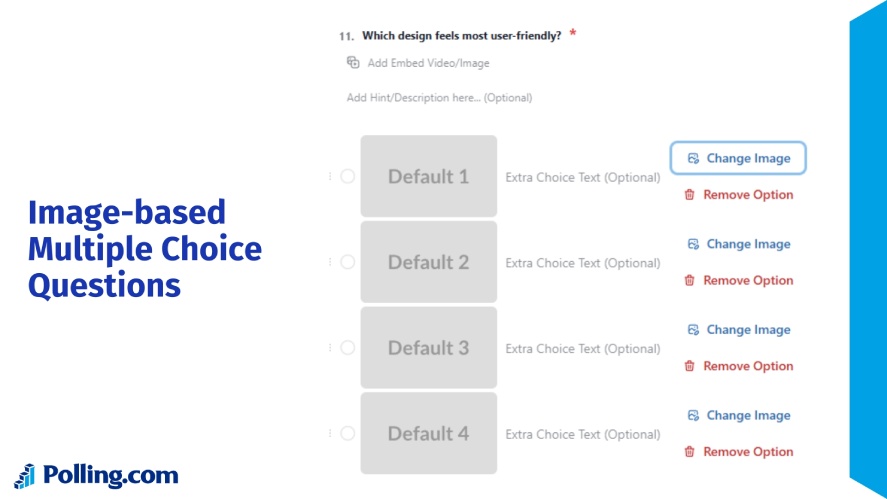
They’re great for usability or branding questions, like “Which design feels most user-friendly?” with screenshots to pick from.
These types of survey questions grab attention and make choosing fun, especially when words alone won’t cut it, giving respondents a clear, visual way to weigh in.
When to Use Multiple Choice Questions in Surveys
Multiple choice questions aren’t just handy, they’re a powerhouse in the right spots.
Here’s when they shine among survey question types, along with some tips to make them work best for respondents.
For Quick Quantitative Analysis
When you need fast numbers, multiple choice questions are your go-to. They’re easy to code and analyze, turning responses into stats without a headache.
Let’s say you ask “How often do you shop here? (Daily, Weekly, Monthly, Never)”. It’s a cinch to tally up percentages or averages from those clean, structured data points.
Among types of survey questions, this MCQ format stands out because it skips the mess of free-text answers, letting you crunch results quick.
So, use them when time is tight and you want solid, countable insights without digging through wordy feedback.
When You Want to Limit Open-Ended Responses
If you’re aiming to keep things tight and consistent, MCQs are perfect for limiting open-ended responses.
A question like “Did our service meet your needs? (Yes, No, Maybe)” instead of a blank “Tell us what you think” ensures data consistency across respondents.

It’s a must for large-scale surveys where hundreds or thousands are answering.
Examples of multiple choice questions like this keep the survey process smooth and uniform. They’re great when you’re scaling up and need types of questions in surveys that play nice with big datasets, not chaos.
When Options Are Clear and Exhaustive
MCQs hit their stride when your multiple answer options are clear and exhaustive, like “What’s your age group? (18-24, 25-34, 35-44, 45+)”.
It helps avoid confusion and boosts response accuracy because respondents aren’t guessing or skipping due to fuzzy choices. Every possibility is covered, and they just pick.
This is key for question types for surveys where you’ve got a finite set, so there’s no room for “None of those” muddling your data.
How to Write Effective Multiple Choice Questions
Crafting multiple choice questions that hit the mark takes some finesse.
Here’s how to keep them unbiased, clear, and effective among survey question types so respondents give you gold.
Keep Wording Simple and Neutral
First up, keep the wording simple and neutral.
Don’t bog respondents down with jargon or pushy vibes like “How awesome was our service? (Great, Good, Okay)”. Instead, go for “How would you rate our service? (Excellent, Good, Fair, Poor)” so it doesn’t nudge anyone toward an answer.
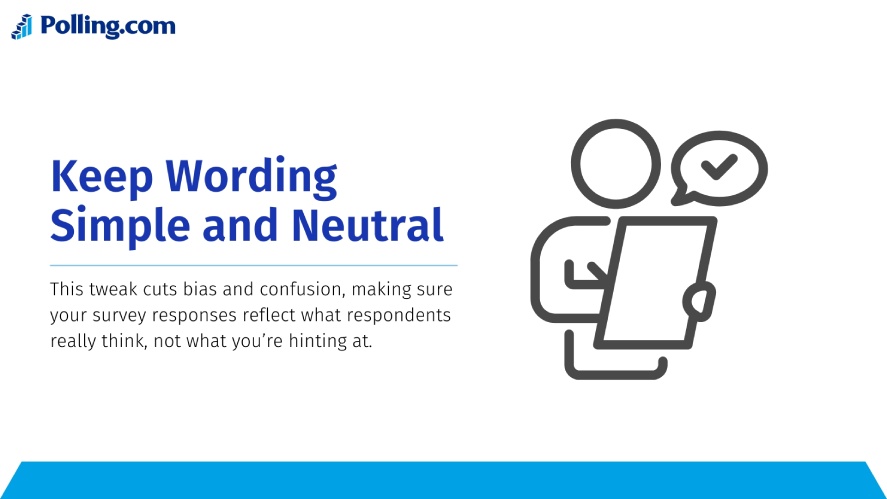
This tweak in question types for surveys cuts bias and confusion, making sure your survey responses reflect what respondents really think, not what you’re hinting at.
Overall, simple language is key to nailing types of questions in surveys that work for everyone.
Make Distractors (Wrong Options) Plausible
Next, make distractors, the wrong or less-chosen options, plausible, not throwaways.
For “What’s your main news source? (TV, Newspaper, Social Media, Magic Crystal Ball)”, that last one is a dud and nobody is picking it, and it skews your data silly.
Swap it for radio button selections and you’ve got a legit set of survey answer choices.
Plausible distractors keep respondents thinking, not laughing, which matters in question types multiple choice for real insights.
Avoid Overlapping Options
Don’t let options overlap.
That’s a trap like “How often do you exercise? (Daily, 3-5 times a week, 4-6 times a week, Never)”. Respondents won’t know if “4 times” fits the second or third slot, and your data gets muddy fast.
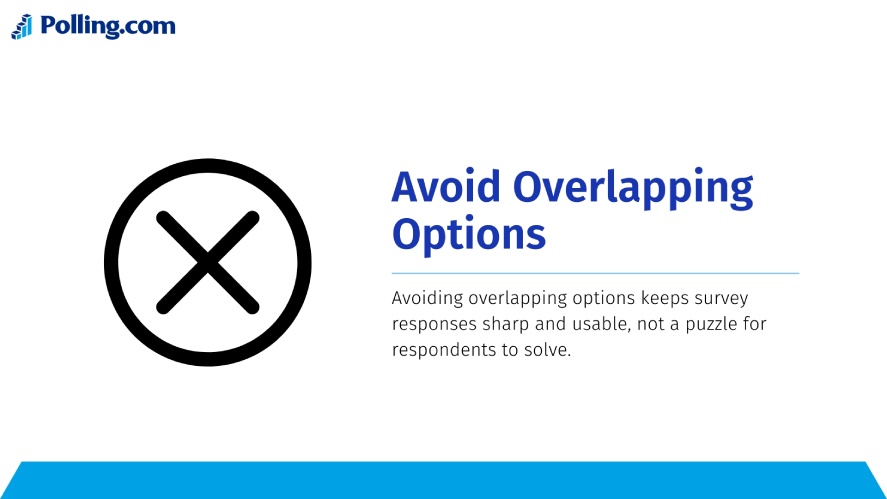
Fix it with clear cuts: “Daily, 3-4 times a week, 1-2 times a week, Never”, so there’s no crossover, no guesswork.
Avoiding this in types of survey questions keeps survey responses sharp and usable, not a puzzle for respondents to solve.
Always Include an “Other” or “None” Option (If Applicable)
Finally, toss in an “Other” or “None” option when it fits.
For example, “Which drink do you prefer? (Coffee, Tea, Soda, None)” or “What’s your pet? (Dog, Cat, Bird, Other)”.
Without these, respondents who don’t match your list might skip or fake an answer, throwing off your multiple choice question data.
It’s a small move in survey question types that covers all bases, keeping your examples of multiple choice spot-on and inclusive.
Analyzing Responses from Multiple Choice Questions
Once you’ve got survey responses from multiple choice questions, the trick is turning those picks into insights.
Here’s how to make sense of them among survey question types.
Use Frequency Distribution for Quick Trends
Start simple and use frequency distribution to spot quick trends in your MCQ data.

If you asked “How satisfied are you? (Very Satisfied, Satisfied, Neutral, Unsatisfied)”, count up how many picked each. Let’s say, 50% hit “Satisfied” and 10% “Unsatisfied”, and you’ve got an instant read on the vibe.
This works fast with question types for surveys because it’s just tallying survey answer choices, showing you what’s hot or not without digging too deep.
Segment Responses by Demographics or Other Filters
Next, slice your responses by demographics or filters to get sharper insights.
Types of survey questions like MCQs make this easy since they filter by age, location, or even “New vs. Returning Users” to see if preferences split.
Examples of multiple choice questions really pop here, as segmenting “Which feature do you use? (A, B, C)” by group shows who loves what, turning basic counts into targeted nuggets for your company.
Visualize Data Through Charts (Bar, Pie, etc.)
Then, bring your data to life and visualize it with charts like bars or pies for a quick, clear story.
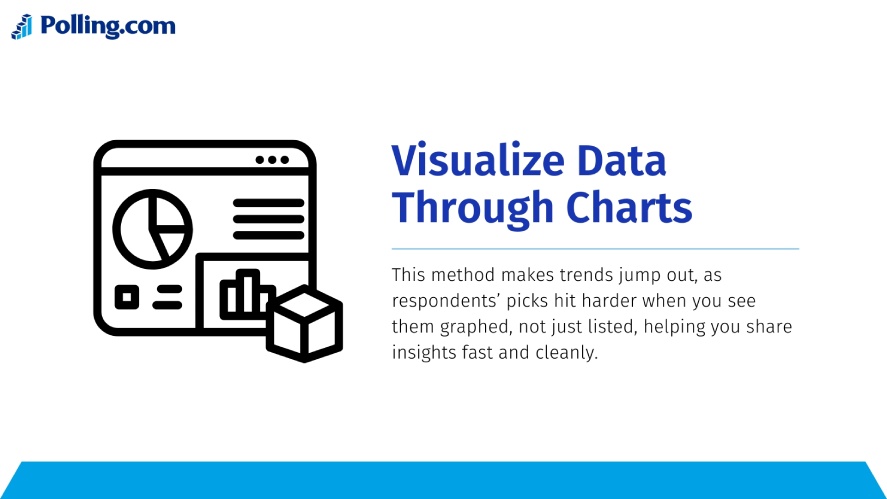
A bar chart for “What’s your favorite product? (A, B, C, D)” might show Product A towering at 60%, while a pie splits “How often do you visit? (Daily, Weekly, Monthly)” into neat wedges.
This trick with survey question types makes trends jump out, as respondents’ picks hit harder when you see them graphed, not just listed, helping you share insights fast and cleanly.
Identify Patterns Over Time or Groups
Finally, dig for patterns over time or across groups.
Let’s say you ask “How is our service? (Great, Good, Okay, Poor)” every quarter. Tracking shifts from 70% “Great” to 50% over months flags a dip to fix.
Or compare groups: “Did urban vs. rural respondents like our event?” from a multiple choice question shows who’s vibing more.
Types of questions in surveys like these let you spot long-game trends or splits, turning raw answers into big-picture wins for your strategy.
Want to get clear insights with multiple choice questions? Polling.com’s dashboard offers instant breakdowns of MCQ responses for clear results.
Advantages and Limitations of Multiple Choice Questions
Multiple choice questions are a big deal among survey question types, but they’ve got their highs and lows.
Here’s the scoop on what they bring and where they fall short.
Advantages of Multiple Choice Questions
MCQs pack some serious perks that make them a go-to for surveys.
First, they’re scalable, whether you’re polling 10 people or 10,000, questions like “What’s your favorite feature? (A, B, C)” handle big crowds without breaking a sweat, spitting out clean data fast.
Plus, they’re easy for respondents. Just a quick tap or click on survey answer choices like “Yes, No, Maybe”, no typing required.
Lastly, they play nice in digital formats. Types of survey questions like these fit perfectly on phones or laptops, making them a breeze for online polls or apps where speed and simplicity rule.
Limitations of Multiple Choice Questions
Multiple selection questions aren’t perfect, they’ve got downsides you can’t ignore.
For one, they may restrict nuanced feedback. A multiple choice question like “How’s our service? (Good, Bad, Okay)” boxes respondents in, missing the “why” or “how” you’d get from open-ended questions.
Plus, poorly designed options can skew results.
For example, a question like “How often do you visit? (Daily, Often, Sometimes)” has overlapping answers or misses “Never”.
This can toast your data, and it’s a trap in types of questions in surveys that muddies the truth.
Why Polling.com is the Best Tool for Creating Multiple Choice Surveys
When it comes to crafting multiple choice questions for your surveys, Polling.com stands out as the top pick.
Our drag-and-drop MCQ builder makes it simple to create question types for surveys, just grab and slide in options, no coding needed.
Plus, the tool has pre-built templates packed with multiple choice options, like customer feedback or event polls, so you’re not starting from scratch, saving you time on types of survey questions.
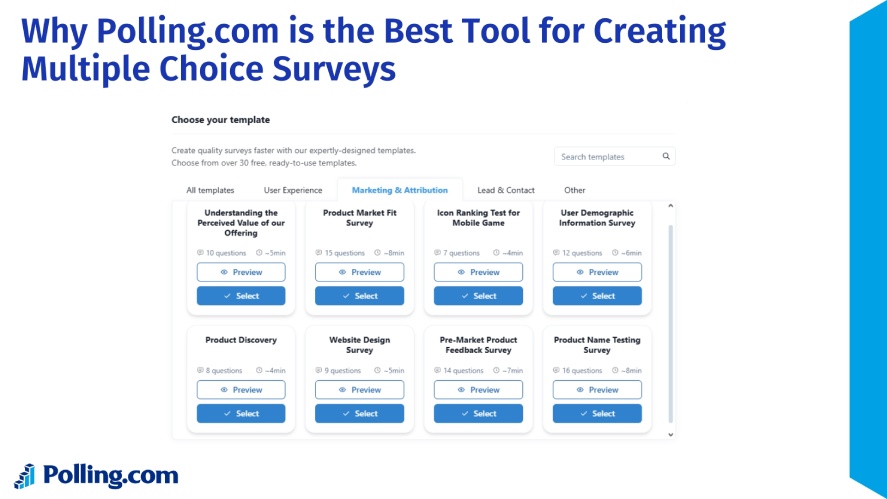
Real-time analytics are built right in, too. With Polling, you can watch responses roll in and see trends pop up instantly, no waiting around.
For advanced surveys, customization and branching logic let you tweak designs based on answers for digging deeper.
Compared to Typeform, which leans hard into flashy design but skimps on quick analytics, or SurveyMonkey, loaded with features but trickier to navigate, or Google Forms, free but bare-bones, Polling.com’s unique edge is its blend of ease, power, and instant insights, making survey question types a breeze to handle.
Conclusion
Versatile enough for quick stats, broad preferences, or detailed ratings, multiple choice questions are a key player among types of questions in surveys, giving you clean data fast while keeping respondents happy.
From single-answer picks to dropdowns or Likert scales, examples of multiple choice questions show they can fit any need, though they’ve got limits like missing nuance if you don’t design them right.
Want to see their value in action? Build your next survey on Polling.com—it’s got the tools to make question types multiple choice shine, whether you’re polling a handful or a crowd.
Get started with our free survey builder and create powerful multiple choice questions today!
